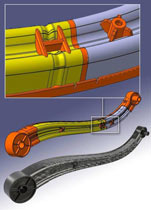
Swiss mould maker Georg Kaufmann, together with partners, has developed the LIPA (Lightweight Integrated Process Application) technology for the mass production of lightweight composite parts.
Cut-to-size blanks of Tepex organic sheet – a fabric-reinforced thermoplastic – are first pre-heated and then placed in the mould, where they are thermoformed and at the same time provided with moulded-on ribs, bearing eyes and other working parts with the aid of the long-fibre direct injection moulding process developed by German injection moulding machine maker Arburg
The result is a lightweight part of extremely high strength and stiffness. The entire production process will be demonstrated at K2013 on the Arburg exhibition stand (A13 in Hall 13) on a hydraulic Allrounder 820 S equipped with servo hydraulics. The machine and mould will be producing a demonstration part similar, for example, to a swing arm for a bicycle or a structural element in a car seat.
For the production of the demonstration lever, two cut-to-size organic sheet blanks of different thicknesses are gently heated up to thermoforming temperature in synchronism with the moulding cycle of the machine. A robot equipped with a vacuum gripper safely transfers the blanks with a minimum of delay into the mould cavity where they are thermoformed into a W-shaped profile. This not only increases the rigidity of the lever but also ensures a full-surface, firmly pressed, positive connection between the two component sheets. Stiffening ribs and an edging of long fibre-reinforced plastic are then injection moulded onto the organic sheets.
As the temperature of the organic sheets is only slightly below the melting temperature of the base polymer, a perfect bond is ensured. For the same reason it is also possible to produce moulded-on elements (e.g. screw bosses) by injecting through the organic sheet without causing any damage to the fibre structure in the moulded part. In order that it can be connected to a mating part in a downstream process, the demonstration lever is provided with a corresponding hole during the moulding operation without adversely affecting the fibre structure.
Apart from the mass production, other benefits include:
- Improvement in the lightweight coefficient through local application of different thicknesses of organic sheet according to the load distribution within the moulded part.
- Reliable bond between the component organic sheets through full-surface, firmly pressed, positive connection.
- Creation of hole in the organic sheet without damaging the fibre structure.
- Encapsulation of the exposed fibres of the cut-to-size organic sheets through a moulded-on all-around edging.
- Reduction in heat-up temperatures for the organic sheet through minimum temperature loss during the moulding cycle.
- Long-fibre direct injection moulding readily permits flexible combinations of material through variations in fibre length and content.
- Significant cost benefits offered by long-fibre direct injection moulding thanks to use of cost-saving starting materials.
unit in which thelong glass fibres are cut and mixed
into the melt directly from the roving
(Tepex organic sheet)
operation
suitable for LFRTs
the part
(PRA)
















